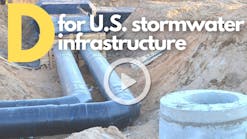Verizon Networkfleet Helps Water District Save Money, Time, and Fuel With GPS Tracking
Many organizations have a misplaced idea that a GPS system is only useful in situations where employees are suspected of misusing vehicles, says Mark Iverson, maintenance director for the Eastern Municipal Water District (EMWD) in Riverside, California.
“Or they think that shaving a few miles off the total number of miles driven in one day is inconsequential,” he adds. “They don’t realize how incremental savings add up to a significant amount of money, or that most employees actually benefit from such devices.”
Iverson speaks from experience. Several years ago, EMWD installed Verizon Networkfleet in 275 of its vehicles. Iverson was pleasantly surprised not only to see almost an immediate return on investment (ROI), but also that the EMWD realized numerous additional benefits, including improved miles per gallon, fewer miles driven per vehicle, rapid dispatch to emergencies or other unscheduled work, improved routing, reduced labor costs, greenhouse gas reduction, improved maintenance, insurance cost savings and protection against false claims.
Also, as a result of the time and money that Verizon Networkfleet’s solution helps EMWD save, the district has the ability to focus on water efficiency at a time when the state of California has recently imposed water restrictions.
The bundled benefits are derived because Verizon Networkfleet offers more than the typical GPS, notes Jerome Toliver, CEO of RMJ Technologies, a fleet optimization company that guided EMWD through the process of selecting an appropriate product.
Diagnostics is what separates Verizon Networkfleet from other systems, Toliver says.
“It is unique to the degree of accurate diagnostics data it provides,” he adds. “Depending on the range, it provides diagnostics data that helps manage a fleet from a preventative maintenance and an ongoing maintenance standpoint where other devices just give you location data.”
RMJ Technologies works with organizations to help them reduce fleet liabilities and increase their efficiencies. The company achieves those goals through many methods, including camera systems, GPS tracking, process automations and driver training. As a reseller of Verizon Networkfleet, RMJ Technologies is the “conduit” between the company and the end user.
Verizon Networkfleet enables end users to track, monitor and manage their vehicle fleets through a combination of vehicle diagnostics, a GPS tracking system and no-cost roadside assistance.
Using an online dashboard, Verizon Networkfleet offers a 360-degree view of fleet vehicles, provides mapping data in street map, satellite or hybrid view, and enables managers to receive alerts if the system detects a problem with the vehicle’s engine, speed or performance.
This is critical for an organization such as EMWD, which has more than 325 vehicles that travel a 550-square mile area providing services in potable water; wastewater collection and treatment; recycled water/conservation; and water, wastewater and recycled water connections.
The district provides service to retail customers located within the 14 cities and unincorporated areas. It also supplies water on a wholesale basis to seven other entities.
In bringing Verizon Networkfleet on board, one of the initial goals of EMWD was to create more efficiencies in its fleet.
“When the district extended the criteria for vehicle life from 10 years/200,000 miles to 12 years/250,000 miles, we began a study that covered all aspects of fleet management and efficiency,” says Iverson. “This assessment resulted in changes that have already yielded substantial cost savings and will undoubtedly prolong the life of our fleet.”
Verizon’s Networkfleet was chosen from among 25 fleet management products for its plug-and-play installation capability, 24/7 roadside assistance and potential savings in operating costs. Its web-based fleet software with online dashboard provides a summary view of vehicle location and engine diagnostics, among other elements. The software’s detailed information is designed to help reduce operational costs, enhance customer service and improve vehicle performance and safety.
Due to its multiple responsibilities, EMWD’s fleet runs a variety of routes.
“There are water operators who run routine routes to manage their parts of the water distribution system, meter readers on their routes and mechanics and electricians who use vehicles to go to various places in the district. There are vacuum trucks used in stormwater and sewer maintenance, dump trucks, boom trucks and sewer maintenance trucks. The only thing we don’t have Verizon Networkfleet on is our construction equipment,” says Iverson. “Everything that rolls down the road that can be driven, we have it on.”
Installation was easy, notes Iverson, adding that it took less than 30 minutes per vehicle for EMWD employees to install the system without hiring additional staff.
The device is simple in that it is installed into a vehicle without the need for splicing or cutting wires, says Toliver. Verizon Networkfleet also offers full installation services and asset tracking for mobile equipment.
Initially, 85 percent of the EMWD fleet was equipped, and in subsequent years the organization did not equip any vehicle model older than 1996. Now each time EMWD acquires a new vehicle, it is equipped with Verizon Networkfleet. Presently, 325 vehicles have Verizon Networkfleet installed.
The EMWD derived an ROI much sooner than anticipated in terms of savings in fuel, maintenance and insurance costs. “We implemented this in 2007 and 2008 when the economy was really in a bad way and it was difficult for us to justify it to our board, but we made a case for its payback,” says Iverson.
His department predicted the system would pay for itself within a year based on savings and miles driven through more efficient dispatching of closest vehicles and labor cost reductions. Those factors actually produced an ROI in less than three months, Iverson adds.
“We made a key point in the first year after we installed Verizon Networkfleet to go back to the board and say we achieved our ROI. Subsequently, we tracked it year after year,” he adds.
When Iverson and his colleagues first presented the idea of installing Verizon Networkfleet in EMWD vehicles to its board, a net benefit of $397,000 was predicted. The actual benefit after the first year was $690,000.
“That included the system cost, the implementation, our net benefit, looking at labor efficiency and the smog reduction,” says Iverson.
The EMWD used numbers recommended by the South Coast Air Quality Management District for different vehicle types and noted the reduction in emissions, says Iverson, adding that EMWD was successful in obtaining federal funding based on those emissions reductions.
At one time, EMWD vehicles were involved in up to 15 accidents a year, with payoffs on claims as high as $250,000. After one particularly bad accident resulting in a large settlement and subsequent insurance rate concerns, EMWD’s legal counsel suggested GPS tracking in its vehicles would have enabled a better determination of speed and direction.
The initial decision to not have GPS was rooted in union concerns, “but it turns out it’s not a union issue,” says Iverson. “From a legal standpoint, public entities have a right to put these on vehicles and use them. We did get buy-in from the union.”
The result: “Our vehicle accident rate went down to less than four a year,” notes Iverson. “Then payoffs on claims went down to less than $10,000 a year.” EMWD has not had any accidents of the magnitude of the one experienced before the Networkfleet installation, notes Iverson.
The numerous additional benefits were immediate and have been sustained over the years. They include:
- Improved miles per gallon driven while reducing speed-related accidents. As a result of the accidents, EMWD focuses on drivers’ habits, including their impact on fuel usage through speed and idle time. Supervisors receive alerts from Verizon Networkfleet if drivers exceed a certain speed limit.
- Fuel cost reduction through idle time management. Within the first six months of operation, EMWD employees drove about 165,000 fewer miles, and fuel costs declined by about $79,000 as compared to the previous year’s data for the same period. “We know what the idle times are across the industry, so we can begin to look at what an individual customer’s idle time is and let them know they are above the norm,” says Toliver. “Organizations can coach their employees and create incentives, such as having one group compete against another to get the lowest idle time possible and get rewarded.”
- Rapid dispatch to emergencies or other unscheduled work. The technology’s integration with GIS mapping, enabling end users to see all of the pipes in their underground infrastructure through digital maps of the territory, offers efficiencies, Toliver says. “You can see what vehicle is closest to a main break if it’s the type of vehicle you need to address that issue,” he adds. Says Iverson: “This capability is also vital when there is an accident in the field, because we can pinpoint the location and better direct emergency services to the accident scene.” In the case of an emergency or disaster response, fleet managers can utilize the technology to determine vehicle locations and direct employees out of the path of a disaster or get assistance to them via their last known location, Toliver says.
- Improved routing. Better routing results in less time behind the wheel, giving EMWD employees more time to focus on work-related tasks and significantly reduce the work backlog. “Employees who go on remote service calls at all hours gain peace of mind by knowing that Verizon Networkfleet can pinpoint and track their location information,” says Iverson.
- Significantly reduced labor costs. “We look at the reduction in the miles driven between our baseline year, which is 2007, and all of the subsequent years because essentially we’re a mature agency—we’re not growing in terms of the number of vehicles or the number of people,” says Iverson. “If I look at what we were doing before GPS, I see a reduction of miles driven. I also know the average speed of the vehicles driven, which is right around 29 miles an hour. At 29 miles an hour and the miles saved, you do the math and come up with hours that they’re not driving. If they’re not driving, they’re available to do their job. We saw an increase in the number of work orders completed and a decrease in overtime all at the same time.” Adds Toliver: “If I know that I am now driving 10,000 miles less than I did last year, I can assign time to that and therefore a burden wage rate. I can’t say what my employee was doing with that time when they were not behind the wheel but I know that I can have them doing something efficient for the district.”
- A measurable greenhouse gas reduction. With more than 300 vehicles equipped with Networkfleet, EMWD has seen a significant reduction in carbon dioxide emissions. In addition to CO2, EMWD has reduced vehicle emissions for carbon monoxide, nitrous oxides, PM10 (particulate matter) and methane. “Networkfleet automatically collects emissions data, which eliminates the need to bring vehicles in for biennial smog checks,” says Iverson. “Proactive maintenance and automated smog checks save both time and money.”
- Protection of the agency and its employees against false claims, which Iverson notes was not considered when predicting an ROI. When someone calls in to falsely claim that an EMWD vehicle backed in to their vehicle, “we can look at the records and find out that our vehicles were nowhere near there,” Iverson notes, adding the GPS readings can also be used to prove drivers were not speeding at the time of an accident. “It gives the risk management people a tool. It also helps the employees a lot more than we anticipated.” There was fear among EMWD employees that the use of Verizon Networkfleet would mean they would be reprimanded for driving fast, Iverson says. “It actually protects them because we get calls that people are driving too fast in their neighborhood or sleeping in a vehicle and, upon investigation, we can tell them it’s absolutely not true. We know exactly how fast they were going, when they were there and why they were there.”
- Improved maintenance. Because of Networkfleet’s connection to the engine’s OBD-II, EMWD can now remotely monitor engine diagnostics, fault codes and emissions control system status. EMWD staff receive an immediate alert of an engine problem, allowing them to proactively repair the vehicle before the problem worsens. Networkfleet’s diagnostic information, alerting and reporting capabilities also help mitigate issues arising from warranties not being honored due to improper maintenance. “Employees had a tendency to continue to drive vehicles even after the check engine light went on,” says Iverson. “Now we are notified of all Diagnostic Trouble Codes that activate the check engine light and can make sure all of our vehicles are maintained properly. We are also notified of any manufacturer recalls for the entire fleet. The fact that we can diagnose vehicle problems through the vehicle’s computer system has proven very beneficial for us. Not all systems have that. But the Verizon Networkfleet product does, and our fleet mechanics use that extensively to troubleshoot.”
- Insurance liability cost reductions. “Before we purchased Verizon Networkfleet, our insurance premiums were scheduled to go up due to a rise in speed-related accidents,” says Iverson. “Now that we can monitor and help control driving habits, our premiums have actually gone down.”
- Reduced fleet size. “The technology shows them they’re not using their vehicles to a certain degree and they can downsize,” says Toliver.
- The ability to focus on water conservation.
EMWD expects long-term and recurring benefits from Verizon Networkfleet to be extended life of its 350-vehicle fleet, continued savings from fuel usage, incremental savings from reduced insurance premiums, elimination of physical smog checks, improved maintenance and engine diagnostic capabilities, and improved employee safety and peace of mind.
“The money we save in fuel and labor more than pays for our monthly Networkfleet subscription fee,” says Iverson.
Those savings are being realized in other districts as well. In addition to EMWD, which purchases its water from the Metropolitan Water District of Southern California, the largest supplier of treated water in the United States, RMJ Technologies also works with many other water districts and municipalities in California, including the Coachella Valley Water District, the Fresno Metropolitan Flood Control District, the Indio Water Authority, the Los Angeles Department of Water & Power, the Metropolitan Water District, the Rancho California Water District, the Santa Clarita Valley Water District, the Soquel Creek Water District, the South Tahoe Public Utility District, the Western Municipal Water District, the Yorba Linda Water District and the Yuima Metropolitan Water District.






